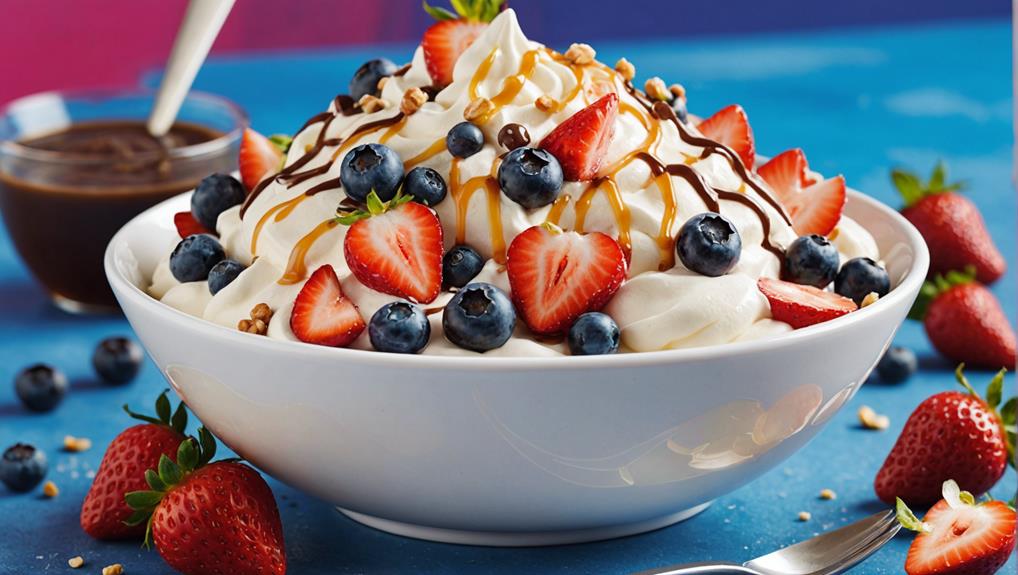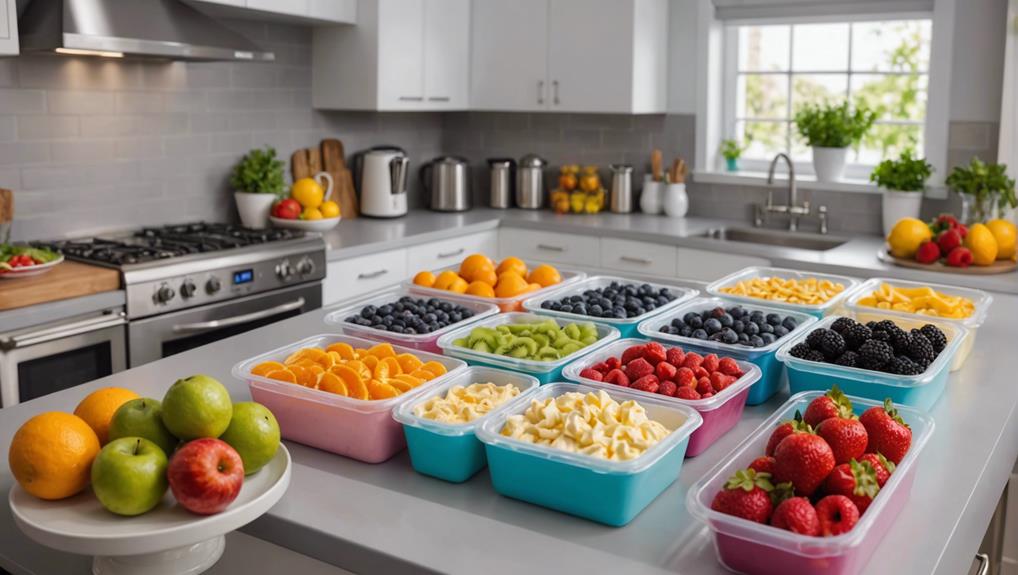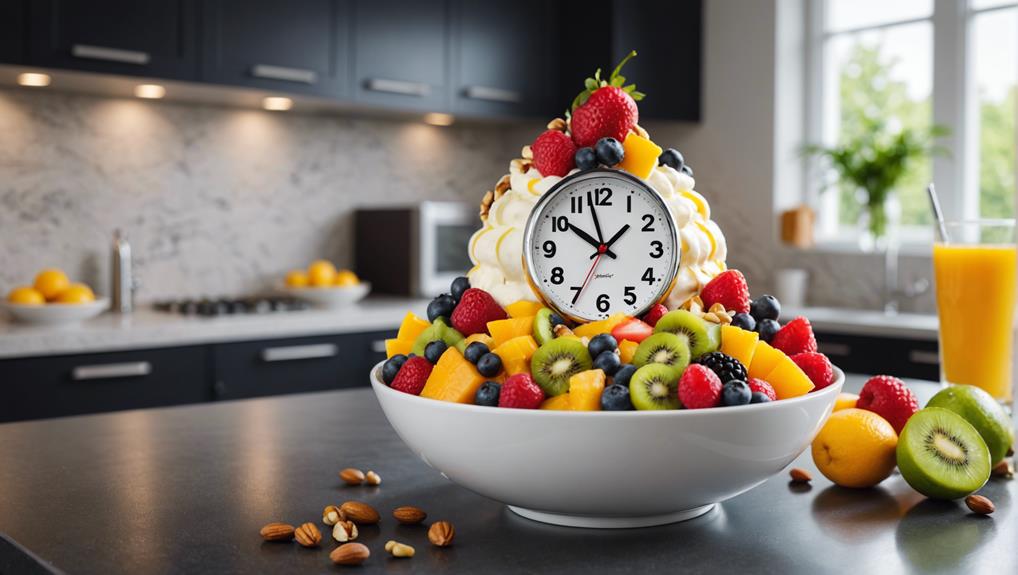Frozen yogurt is an excellent choice for picky eaters, offering essential nutrients like calcium, protein, and probiotics. Calcium supports strong bones and teeth, while protein aids in muscle growth. Probiotics promote gut health. Frozen yogurt's creamy texture is particularly appealing. It typically has fewer calories and fat than ice cream. To enhance its nutritional profile, consider adding toppings such as fruits, nuts, or granola. Opt for plain Greek yogurt with low sugar content, utilizing natural sweeteners for added flavor. With versatile and creative topping options, it is possible to satisfy even the most discerning palates while also boosting nutritional intake.
Key Takeaways
- Frozen yogurt's creamy texture often appeals to picky eaters, making it a more accepted treat.
- Offering a variety of flavors and toppings can increase acceptance and enjoyment in selective eaters.
- Nutritional toppings like fruits, nuts, and granola enhance both flavor and health benefits.
- Plain Greek yogurt with natural sweeteners can be a low-sugar option for picky eaters.
- Creating fun recipes like yogurt popsicles or frozen yogurt bark can make eating more enjoyable.
Benefits of Frozen Yogurt

Frozen yogurt offers multiple nutritional benefits for picky eaters, including essential calcium, protein, and probiotics. These nutrients are pivotal for growth and development, particularly in children. Calcium is vital for the formation and maintenance of strong bones and teeth, while protein supports muscle growth and repair. Probiotics, the beneficial bacteria found in frozen yogurt, contribute to a healthy gut microbiome, which can enhance digestive health and support the immune system.
The creamy texture of frozen yogurt may appeal particularly to picky eaters who are reluctant to consume other dairy products. Many children find the texture and taste of traditional dairy products unappealing; however, frozen yogurt's smooth consistency and pleasant flavor can make it an attractive alternative. Additionally, compared to ice cream, frozen yogurt is often lower in fat and calories, providing a healthier dessert or snack option without compromising taste.
Incorporating a variety of toppings such as fruits, nuts, and granola can further enhance the nutritional profile of frozen yogurt. These additions introduce additional vitamins, minerals, and fiber, making the treat even more nutritious and enticing for picky eaters. Offering frozen yogurt with such toppings can also introduce children to new flavors and textures in a fun and enjoyable way.
Choosing the Right Yogurt
Selecting the appropriate type of yogurt is important for ensuring that picky eaters receive the best nutritional benefits while enjoying their meals. Plain Greek yogurt is a highly recommended option due to its thick, creamy texture and high protein content, which can be particularly appealing to picky eaters. Additionally, opting for yogurt with low sugar content is vital to prevent excessive sugar intake, which can contribute to various health issues.
For those who find plain yogurt too tart, natural sweeteners such as honey or maple syrup can be added to enhance the flavor without a notable increase in the sugar content. An alternative approach is to choose creamy vanilla yogurt, which often has a more palatable taste for those with refined preferences. However, it is important to carefully read the labels, as some flavored yogurts may contain added sugars and artificial ingredients.
Different yogurt brands and types should be considered based on individual taste preferences and nutritional needs. Greek yogurt, in particular, is often favored for its rich, creamy consistency and higher protein levels. By selecting the right yogurt, parents and caregivers can make sure that even the pickiest eaters enjoy their frozen yogurt while reaping its nutritional benefits.
Creative Topping Ideas

Incorporating a variety of toppings such as dried fruits, nuts, and fresh berries not only enhances the nutritional profile of frozen yogurt bark but also adds appealing textures and flavors. The frozen yogurt bark recipe benefits greatly from the inclusion of versatile toppings. Dried fruits and nuts provide essential vitamins, minerals, and healthy fats, contributing to a balanced diet. Fresh berries, which freeze well, add a burst of color and antioxidants, making the yogurt bark visually appealing and healthful.
Creative topping ideas extend beyond traditional choices. Chocolate chips, for instance, introduce a hint of indulgence without overwhelming the health benefits. Coconut flakes can add a tropical twist, while raisins bring a natural sweetness. Combining these elements can lead to a nuanced flavor profile. For example, mixing yogurt with honey, cranberries, and raisins before spreading it on a baking tray ensures a harmonious blend of taste and texture.
To achieve the best results, it is important to freeze the yogurt bark with toppings for 2-4 hours until it is completely solid. This process not only preserves the integrity of the toppings but also ensures a satisfying, crunchy snack that appeals to picky eaters.
Fun Recipes to Try
Creating engaging and nutritious frozen yogurt treats can be an effective strategy for encouraging picky eaters to consume a more diverse range of foods. One of the most popular fun recipes is making frozen yogurt bark, a healthy snack that can be tailored to individual preferences. This recipe involves spreading a layer of yogurt on a baking sheet and customizing toppings to cater to the picky eater.
Incorporating natural sweeteners such as honey or maple syrup can enhance the flavor without adding refined sugars. Additionally, experimenting with different toppings, such as fresh berries, nuts, and chocolate chips, can make the yogurt bark more appealing. Customizing frozen yogurt drops with fun shapes and colors also provides a visually enticing option for children who may be selective about their food.
Here are some fun recipes to try:
- Frozen Yogurt Bark: Spread yogurt on a baking sheet and top with berries, nuts, and a drizzle of honey.
- Frozen Yogurt Drops: Pipe yogurt onto a tray in small, colorful shapes and freeze.
- Yogurt Popsicles: Mix yogurt with fruit puree and freeze in molds.
- Granola Yogurt Cups: Fill silicone molds with layers of yogurt and granola for a crunchy texture.
Storing Your Creations

To guarantee the longevity and quality of your frozen yogurt creations, it is essential to select appropriate storage containers, such as airtight containers or resealable bags. Maintaining an ideal freezing temperature and labeling containers with the date of preparation will help track freshness and optimize consumption. Proper storage practices, including keeping items in a single layer and avoiding repeated thawing and refreezing, can preserve both texture and taste for up to three months.
Proper Container Choices
Selecting the appropriate containers is essential for maintaining the quality and freshness of your frozen yogurt creations. Proper container choices not only prevent freezer burn, but also guarantee that the texture and flavor of the yogurt are preserved over time. Various container types serve distinct purposes and can be chosen based on the specific needs of your frozen yogurt products.
For the best storage:
- Plastic containers: Ideal for freezing individual portions, these containers provide a sturdy, reusable option that can be easily stacked.
- Silicone molds: Perfect for creating small, manageable servings, silicone molds are flexible and make it easy to pop out frozen yogurt portions without damage.
- Mason jars: These are excellent for storing frozen bark or drops. Their airtight seal helps maintain freshness, while their stackable nature maximizes freezer space.
- Freezer-safe bags: Suitable for storing yogurt on the go or in limited freezer space, these bags can be labeled with dates to track freshness and ensure timely consumption.
When selecting storage solutions, consider the type of frozen yogurt you are making and the space available in your freezer. Utilizing various container types strategically can enhance both the longevity and enjoyment of your frozen yogurt creations.
Ideal Freezing Temperature
Maintaining the ideal freezing temperature of around 0°F (-18°C) is paramount to preserving the texture and flavor of your frozen yogurt creations. This specific temperature setting ensures that the frozen yogurt achieves and maintains the desired consistency without becoming overly hard. The structure of frozen yogurt is particularly sensitive to temperature fluctuations; hence, maintaining a consistent freezing temperature is essential for prime storage.
Freezing temperatures lower than 0°F can lead to the formation of larger ice crystals within the yogurt, which negatively impacts the texture, making it grainy and less palatable. Conversely, temperatures higher than 0°F may not sufficiently solidify the yogurt, resulting in a suboptimal texture and potential spoilage. It is crucial to periodically check and adjust your freezer settings to ensure they remain at the ideal freezing temperature.
Proper storage at this temperature not only preserves the texture but also maintains the quality and flavor of the frozen yogurt over time. When stored correctly, frozen yogurt can retain its optimal taste and consistency for up to 2-3 months. Adhering to these guidelines ensures that your frozen yogurt remains a delightful treat for even the most discerning palates.
Labeling and Dating
Effective labeling and dating of your frozen yogurt creations are essential practices for guaranteeing peak freshness and quality. Labeling allows for easy identification of flavors and ingredients, which is particularly beneficial for those with dietary restrictions or preferences. Dating your frozen yogurt ensures that you consume it within a prime timeframe, reducing the risk of spoilage and maintaining the best taste and texture.
When storing your frozen yogurt, using airtight containers or bags is crucial. These storage solutions prevent freezer burn, which can compromise both the flavor and texture of your creations. Proper labeling and dating can aid in achieving these objectives effectively.
Consider the following tips for optimal labeling and dating:
- Use waterproof labels: Ensure labels are resistant to moisture to avoid smudging.
- Include all necessary information: Identify flavors, ingredients, and any special dietary considerations.
- Date clearly: Use a consistent date format to track the age of your frozen yogurt.
- Rotate stock: Consume older batches first to maintain a fresh supply.
Tips for Success
To enhance the appeal of frozen yogurt for picky eaters, it is essential to offer a variety of flavors and creative topping choices. Research indicates that providing multiple options can increase acceptance and enjoyment in children with selective eating habits. Incorporating elements such as fruits, nuts, and granola can further enrich the sensory experience and nutritional profile.
Flavor Variety Matters
Providing a diverse range of yogurt flavors is essential for accommodating the varied taste preferences of picky eaters, as it increases the likelihood of acceptance and enjoyment. Research indicates that offering multiple yogurt flavors can greatly enhance the appeal of this nutritious option, making it more enticing for picky eaters. By rotating flavors, caregivers can maintain mealtime variety, thereby preventing monotony and potential aversions. Introducing new flavors gradually also plays an important role in expanding the palate of picky eaters, encouraging a more adventurous approach to food.
Incorporating mix-ins, such as fruits, nuts, or granola, can further elevate the sensory experience, adding both flavor and texture. This strategy not only makes the yogurt more appealing but also enhances its nutritional profile. For a successful approach to flavor variety, consider the following tips:
- Experiment with a range of yogurt flavors: Try fruity, creamy, or tangy options to find what best entices picky eaters.
- Introduce new flavors gradually: Slowly add different flavors to help expand the palate.
- Incorporate mix-ins: Enhance flavor and texture with fruits, nuts, or granola.
- Rotate flavors regularly: Keep mealtime interesting by varying yogurt flavors frequently.
Creative Topping Choices
Incorporating a variety of creative toppings can greatly enhance the sensory appeal and nutritional value of frozen yogurt for picky eaters. Frozen yogurt bark serves as an excellent medium for integrating diverse textures and flavors that can captivate and satisfy even the most selective palates.
Dried fruits and nuts are particularly advantageous as toppings. They not only introduce a delightful crunch but also contribute essential vitamins, minerals, and healthy fats. Fresh berries, known for their vibrant colors and antioxidant properties, freeze exceptionally well, adding both visual allure and nutritional benefits to the frozen yogurt bark. Additionally, chocolate chips can provide a touch of sweetness and indulgence, making the treat more enticing without overwhelming the palate.
To create an appealing base, consider mixing yogurt with honey, cranberries, and raisins before spreading it on a baking tray. This blend ensures a consistent flavor profile that complements the various toppings. Coconut flakes and raisins are additional creative toppings that can diversify the taste and texture profile. Making sure the yogurt bark is frozen for 2-4 hours is essential for achieving the best texture and taste. Utilizing these elements strategically can transform frozen yogurt into a delectable and nutritious option for picky eaters.
Frequently Asked Questions
Is Frozen Yogurt Easily Digestible?
Yes, frozen yogurt is generally easily digestible due to its lower lactose content and the presence of probiotic benefits and digestive enzymes, which support gut health. Additionally, dairy alternatives can mitigate digestive issues for sensitive individuals.
Is Frozen Yogurt Softer Than Ice Cream?
In a texture comparison, frozen yogurt is generally softer than ice cream due to its lower fat content and higher water content. This difference, coupled with varying sweetness levels and ingredient differences, influences melting point and serving temperature.
Can You Freeze Yogurt and Eat It Like a Popsicle?
Yes, you can freeze yogurt and eat it like a popsicle. The freezing process alters the texture to a firmer consistency. DIY popsicles offer flavor variety and serving suggestions, including sweet toppings, enhancing the overall experience.
What Is Healthier Frozen Yogurt or Soft Serve?
Choosing between frozen yogurt and soft serve is like selecting between two paths of wellness; frozen yogurt generally offers superior nutritional content, lower sugar levels, probiotic benefits, reduced calorie count, and fewer artificial flavors and fat content.
Conclusion
To sum up, frozen yogurt offers a nutritious and versatile option for picky eaters, providing numerous health benefits when the right yogurt is chosen. Creative toppings and engaging recipes further enhance its appeal, making it a viable alternative to traditional desserts. Concerns about its sugar content can be alleviated by selecting low-sugar or sugar-free varieties. Proper storage techniques guarantee both safety and longevity of these creations. Adhering to these guidelines can effectively address the nutritional needs of selective consumers.







